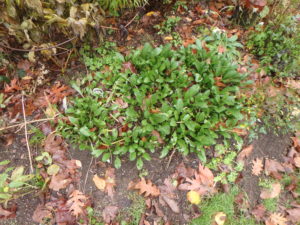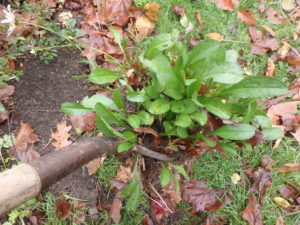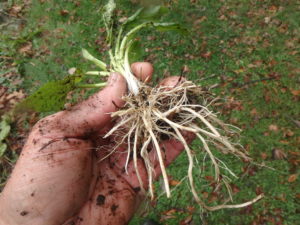Tips for Fall Transplanting
Now is a good time to divide and transplant some of your perennials. I recently dug up and moved Shasta daisies, Siberian iris and snakeroot (Cimicifuga spp). Most perennials can be divided in either spring or fall, and experience is the best way to know what season is best for any given plant. Most plants are not too fussy.
Shasta daisies tend to die out if they are not divided every 3 to 5 years. And you probably have seen iris with a big dead section in the middle of a clump. It’s my belief that the center dies out because the plants have used up all the needed minerals in the soil. This starts in the middle where the original plant began its life.
Why bother digging up and dividing flowers? Some develop into huge clumps that overwhelm a garden bed, or elbow out nice plants next to them. This is particularly true for plants that spread by root like beebalm (Monarda didyma), common orange daylilies and obedient plant (Physostegia virginiana). Those plants can be quite aggressive.
Other plants, heavy-feeders, need to be divided in order to enrich their soil. Once a year I generally sprinkle some slow-release organic fertilizer like Pro-Gro or Garden Tone over Siberian iris to help replenish minerals that get used up. This minimizes the need to divide and re-plant. But digging up and adding compost and fertilizer will help considerably to re-energize a plant.
Here is what I do: I use a garden fork or drain spade (an extra-long spade) to loosen up the roots of a plant by sliding it in under the plant at a 45 degree angle and prying upward. Some plants – daylilies and Siberian iris, for example, hold on tightly. Others, like Shasta daisies and bearded iris have roots near the soil surface and come up easily. You may have to go all around the perimeter with your fork, or just on 2 sides.
I lift the plant out of the ground and place it in a wheelbarrow or on a tarp to minimize soil loss and messiness. Then I use my hands, a shovel or a sharp serrated knife to divide the plant. I like to just split it into several smaller chunks with my hands if possible. But a big chunk of Siberian iris will not pull apart, so cutting through the roots is necessary. I know that seems brutal, but the plant will survive nicely.
If you have invasive weeds or perennials growing near the plant you are dividing, you should be very attentive to the roots. Know the color and texture of goutweed roots, for example. If you see even a smidgen of goutweed root in with the plant you are dividing, STOP! You don’t want to move it to a new area of your garden.
If you are receiving plants from friends, always ask if they have invasives. I got goutweed from a dear friend who kindly gave me some iris – with goutweed roots mixed in. Twenty years later I am still fighting a losing battle with that goutweed.
If you think there might be roots of an invasive plant, either throw it out or bare-root it. Bare-rooting a plant means removing all the soil from the root mass. I do this with a sharp stream of water from my hose. It’s a messy procedure, but getting rid of the soil will allow you to see what roots are part of the plant you want, and what else may be mixed in. Most invasives have distinctive roots.
When you bare-root a plant it is important, when re-planting it, to make sure you get soil to cover all the roots. I will make a hill of soil in the planting hole and drape the roots over it. With my fingers I press soil around the roots, and cover them well. Then I water to get soil to fill in air pockets. Even though air is needed by roots, air pockets will dry out roots, damaging them.
After your plants are lovingly tucked in for the winter, spread some mulch over them. This will slow the soil from freezing, and give the plant more time to establish its roots. I like chopped leaves or pine needles, but chopped bark mulch is fine, too.
When you are cleaning up your flower beds this fall, think about cutting back annual flowers instead of pulling them. If you pull a big sunflower or zinnia, you are leaving an open space that will practically invite weed seeds to infiltrate your garden. If you leave the roots and a little stem, those may decompose over the fall and spring and add organic matter to your soil. And if your flower bed is on a slope, even a gentle one, a bare spot of soil will allow heavy rains to wash off some of your precious topsoil. You can pull those roots when you are ready to plant next spring.
This is also a good time to dig up and get rid of plants that you don’t like, are too aggressive, or are just not thriving. You don’t have to keep every plant. If you don’t like it, get rid of it!
Cold weather is on the way, so if you need to divide plants, you’d better get going!
You may reach Henry at henry.homeyer@comcast.net or by mail at PO Box 364, Cornish Flat, NH 93746. Please include a SASE if you want a response by mail.





